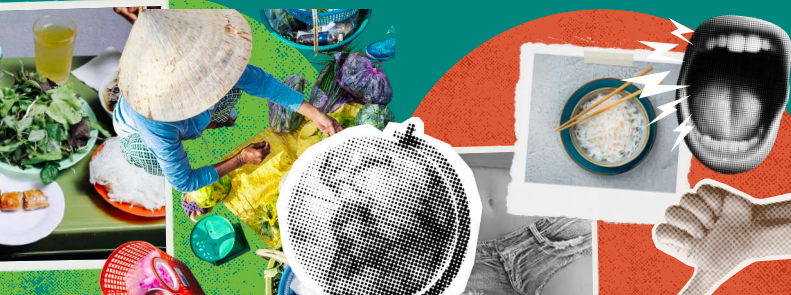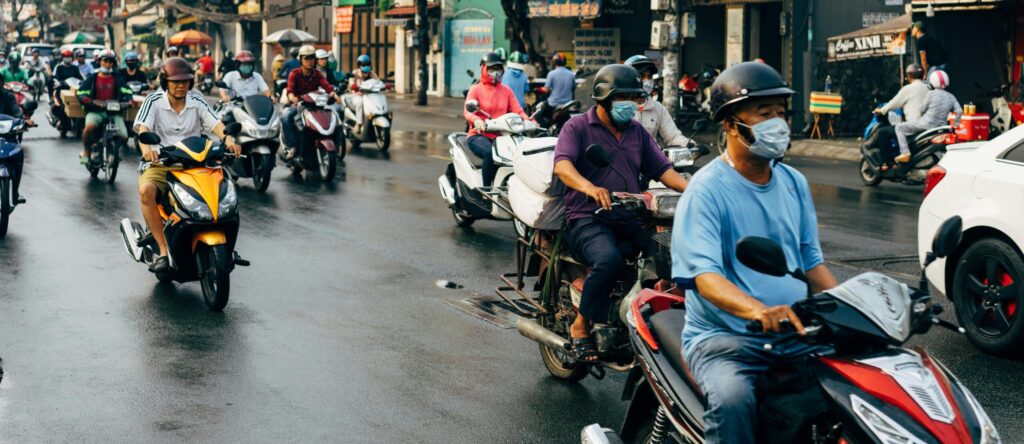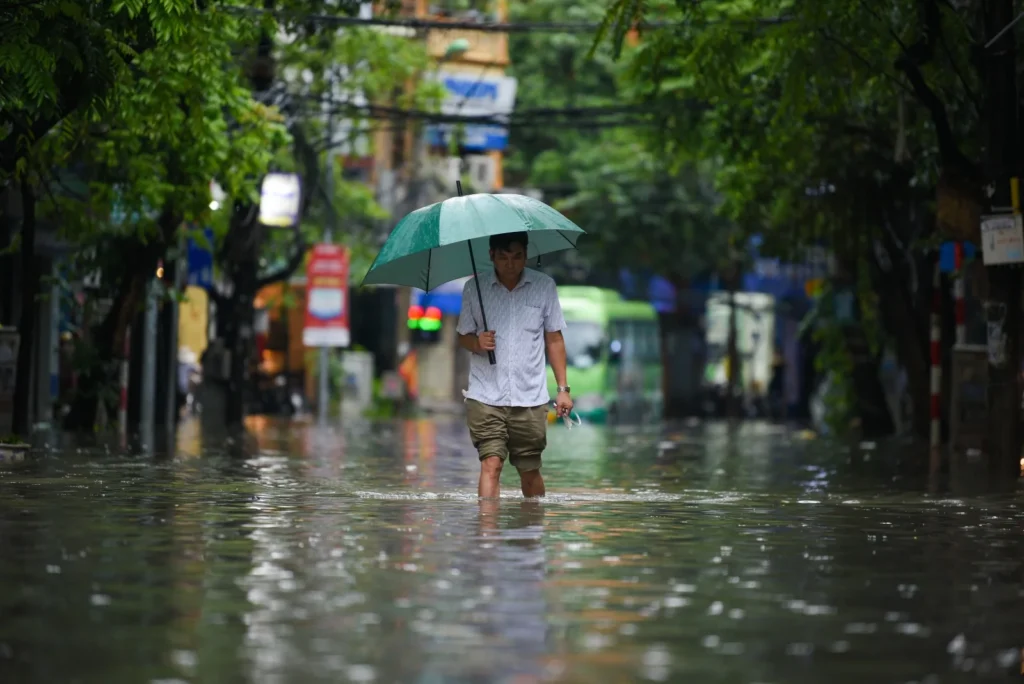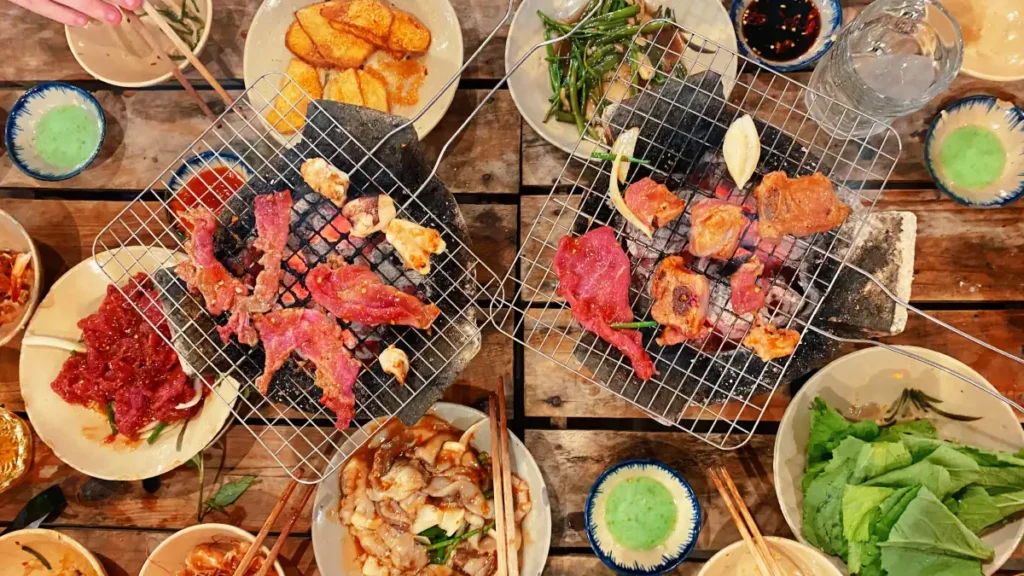Imagine you’re sitting at a street-food cart in Hanoi, the air thick with the scent of lemongrass and sizzling pork skewers, and you hear someone shout, “Xin chào, Bạn khỏe không? ” You realise you don’t know what that means, but you would like to. Welcome to learning Vietnamese – a wild, rewarding ride that is absolutely doable. Whether you’re a traveller, digital nomad, expat (or just plain curious), this beginner’s guide to Vietnamese is your friendly boots-on-the-ground map to get started.
Why Learning Vietnamese Matters (More Than Just “Hi” and “Thank You”)🇻🇳
Let’s get this straight: you can absolutely get by in Vietnam knowing only “xin chào” (hello) and “cảm ơn” (thank you). But speaking Vietnamese opens doors – to deeper connections, better food ordering, and a richer experience overall. Learning Vietnamese is your key to more than tourism: it’s access to culture.
Here are a few quick wins:
-
Locals light up when you greet them in Vietnamese – that first smile is worth it.
-
Navigating Hanoi’s maze-like streets or Hoi An’s alleys becomes a game when you pick up just a few phrases.
-
Cultural nuance matters: for example, the word anh can mean “older brother”, “gentleman”, or just a friendly “you” depending on context. That little bit of language empathy goes a long way.
Fun fact: Vietnamese is a tonal language with six tones in Northern standard (Hanoi) and five in Southern (Ho Chi Minh City). That means the same word said with a different tone might mean completely different things. Don’t let that intimidate you – we’ll break it down in the next section.
The Basics: Pronunciation, Tones & Alphabet
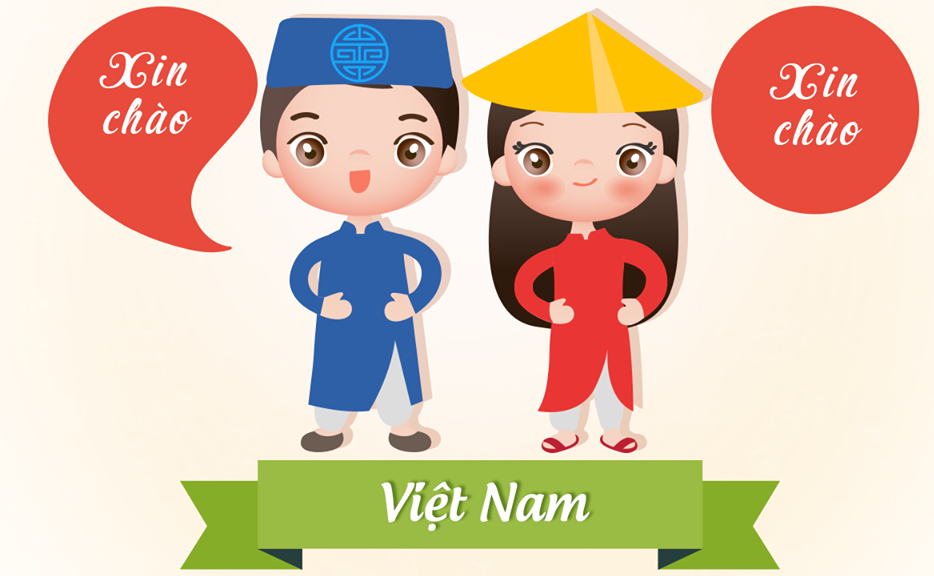
When you’re learning Vietnamese, the first thing you’ll bump into is the weird (beautiful) alphabet and the tones. Let’s keep it simple and friendly.
The Alphabet 🔤
-
Vietnamese uses Latin letters (phew!) but with lots of diacritics (accents).
-
You’ll see things like á, ã, ăng, ẻ, ô. Many feel like typography went wild – but they’re important.
-
Tip: Don’t stress about perfect spelling. Focus on sound for now.
Tones (Yes, they matter) 💡
In Hanoi’s dialect, you’ve got six tones: flat, rising, falling, creaky, hook-above, and dot-below. If you’re in Ho Chi Minh City, it’s typically five tones.
-
Example: ma (flat) = “ghost”, má (rising) = “mother”, mà (falling) = “but/which”, mả (creaky) = “tomb”, mạ (hook above) = “rice plant”, mạ̀ (dot below) = “one’s father/mother” (dialectical).
-
Bottom line: Get the general tone shape (flat vs. rising vs. falling) and you’ll be 80% of the way there. Native speakers will still appreciate you trying even if you make mistakes.
Pronunciation shortcuts 💭
-
“Đ” is like English “D”, but “D” in Northern dialect sounds like “Z”. In the South, it’s closer to “Y”. So “đi” (go) is “dee”.
-
“Ng” at the front of a word? As in “ngon” (delicious) – you’ll hear it everywhere. Pronounce the “ng” like the end of “sing”.
-
“”, “Ê”, “Ô” are distinct vowel sounds. Spend 10 minutes listening and repeating – your ears will thank you.
What stood out for us on the ground: the first time I ordered phở bò (beef pho) and nailed the “ơ” sound in “phở”, the vendor literally grinned. I swear he didn’t give me extra meat – but he clearly liked that I tried. Confidence matters almost as much as correctness.
Must-learn Vietnamese Phrases for Travel & Daily Life
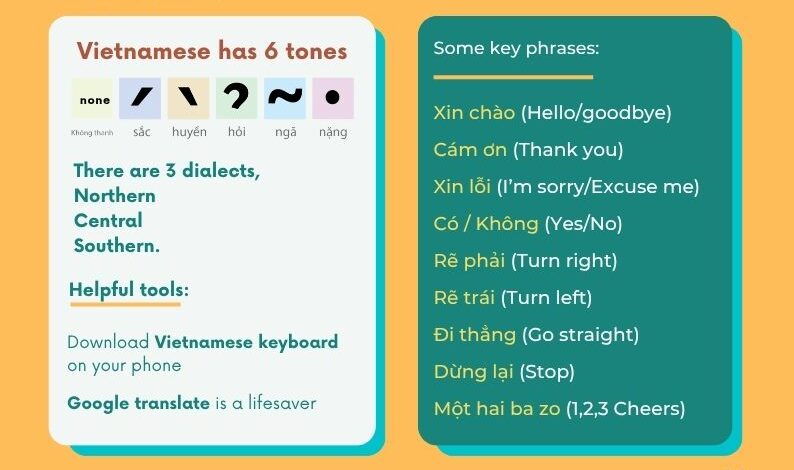
Let’s arm you with the essentials. Learning Vietnamese starts with phrases you’ll use every day.
Situation |
Vietnamese Phrase |
Pronunciation Hint |
|---|---|---|
Hello |
Xin chào |
“sin chow” |
Thank you |
Cảm ơn |
“gahm uhn” |
Sorry / Excuse me |
Xin lỗi |
“sin loy” |
How much? |
Bao nhiêu? |
“bao nyeu?” |
I don’t understand |
Tôi không hiểu |
“toyee khom hyew” |
Delicious |
Ngon |
“ngon” (as in “ng” from “sing”) |
Goodbye |
Tạm biệt |
“tam bee-et” |
Bold full phrases help you just point, say it, and feel good about it. Use these as your first wins.
Also: locals often switch to Vietnamese for bonuses like “Can I give you the discounted price if you say this?” Be game. It’s part of the fun.
Learning Vietnamese: Strategy & Tools That Actually Work
Here’s how to progress from “xin chào” to something a little more robust – without going insane or losing your motivation to learn.
Use real-life practice 🗣️
While travelling in Vietnam, we found the best practice was simply talking to locals (vendors, taxi drivers, hostel clerks) and making a friendly mess of it. They laughed with us, corrected us gently, and we learned more in one afternoon than in a week with an app.
Tech tools 📲
-
Apps: Look at Anki or Memrise for spaced-repetition decks of Vietnamese words. Google Translate can also be helpful in real-time situations.
-
Podcasts & audio: Search YouTube for “Vietnamese daily conversation for beginners” (you’ll find great slow-talk videos).
-
Notebooks: Carry a tiny pocket notebook – write down the phrases you awkwardly butchered and the correct version. Mentally tag it with “funny moment” so you’ll remember.
Sign up for lessons 📚
If you want to get to know the language well or even become a proficient speaker, we recommend taking lessons. This is the best way to ensure you get a good grasp on the basics as well as develop conversational skills. Here are some excellent language classes we recommend:
Cultural Insights That Make the Language Stick
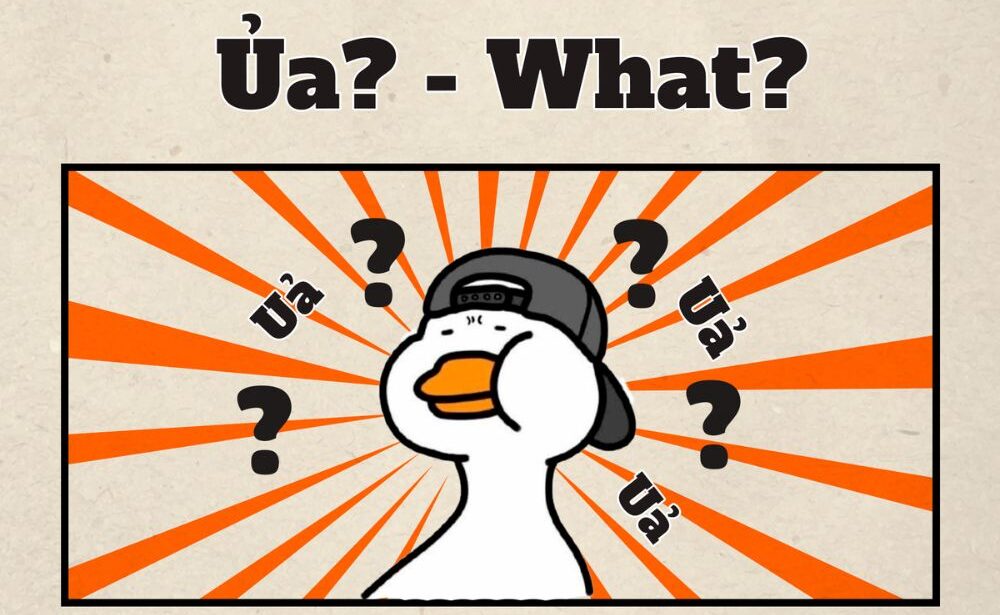
Language doesn’t exist in a vacuum. Here are some cultural hooks that’ll not only help your Vietnamese but also deepen your appreciation for this place.
Respect forms of address
Vietnamese uses family-based titles in everyday speech: anh (older brother/gentleman), chị (older sister/lady), em (younger sibling), ông, bà (sir, ma’am), bạn (friend your age). Using the right one shows you’ve done your homework – and earns goodwill.
For example, you might say “Cám ơn anh” to the scooter rider who helped you cross the street in Ho Chi Minh City. That little “anh” tucks in a bit of respect and camaraderie. When you ask “Bao nhiêu?” at a market and the seller gives you a good price, you might respond with: “Cám ơn anh” (thank you, older guy) or “Cám ơn chị” (thank you, older lady) – simple but appreciated. It’s less about hierarchy and more about acknowledging personhood.
Humour and humility
You’ll fumble. Your tones will wobble. Locals will giggle. That’s fine. Laugh with them. Ask them how to fix your tone – you’ll probably make a friend. I once mispronounced “chợ” (market) and accidentally said something like “Where is the dog?” – we both laughed, and next time the vendor handed me a free piece of fruit.
Dialect differences
Vietnam has dialects. Northern (Hanoi) vs. Southern (Ho Chi Minh), for example. Words like “dạ” (yes) may be more common in the South. As a beginner, pick one version (usually Northern) and roll with it. Most Vietnamese understand both.
Mistakes Beginners Make – And How To Dodge Them
We’ve all been there. Here are trips, stumbles and how to avoid them:
-
Mistake: Only focusing on “tourist-Vietnamese” (just food & directions).
Better: Also learn social phrases, greetings, and simple conversation starters. -
Mistake: Ignoring tones because “it’s too hard”.
Better: Spend 5 minutes a day practising tone drills. Tiny investment, big return. -
Mistake: Waiting until you arrive in Vietnam to start.
Better: Start now. Download an app, listen to a 5-minute vlog. Even if you don’t speak for a week, your ears will acclimatise. -
Mistake: Fear of messing up.
Better: Embrace the mess. Say it wrong, correct it, laugh it off. That’s the fastest way to learn.
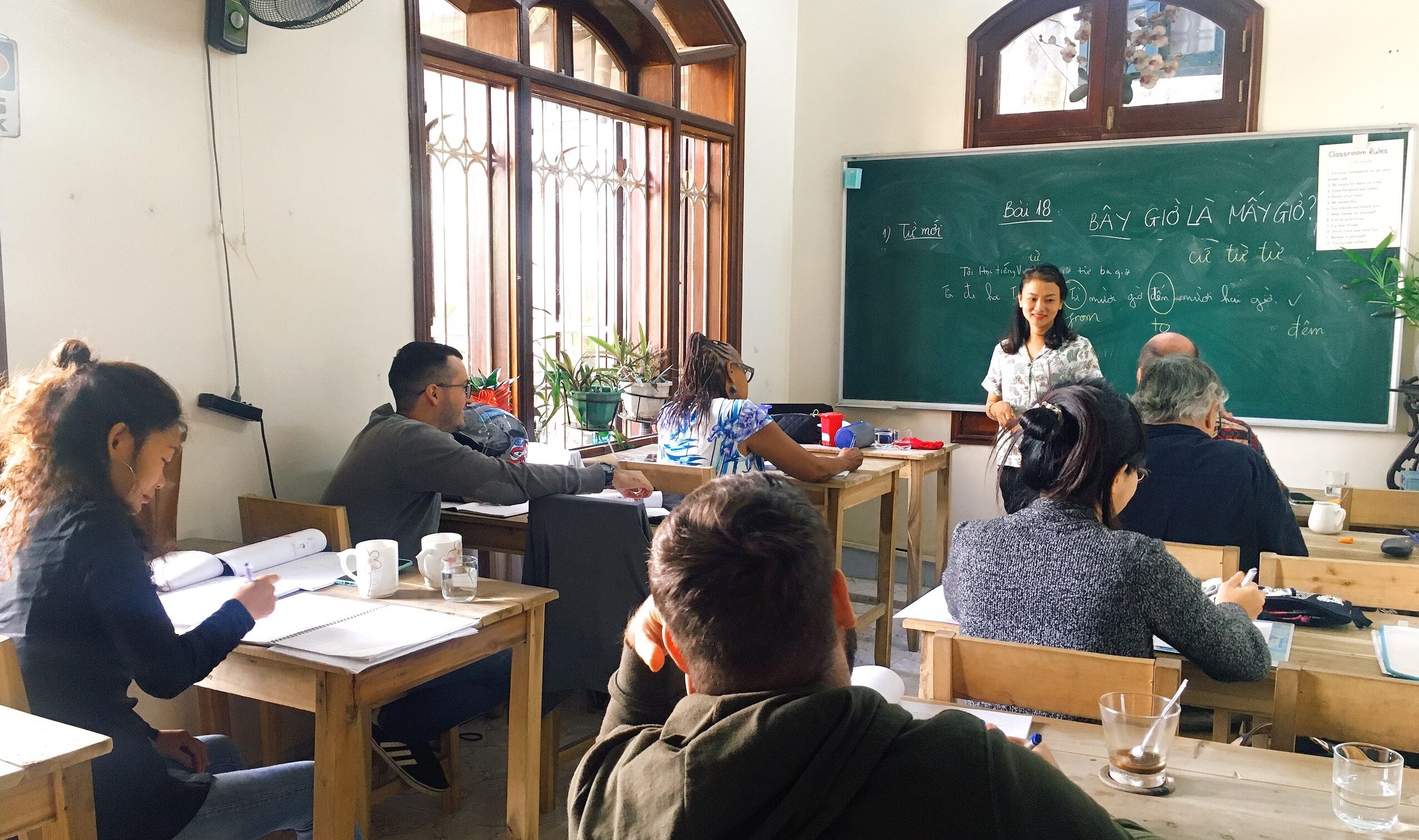
Why I Recommend Learning Vietnamese 🇻🇳
Here’s the deal: The reason I love recommending learning Vietnamese to friends isn’t just because it’s “useful”. It’s because when you try – even imperfectly – you step out of the tourist haze and into the world of locals. That moment when a vendor pauses, smiles and says something back in Vietnamese – that’s pure gold. It means you crossed a bridge.
So go ahead: open your notebook, try “Xin chào” with gusto, nail the tone for “cảm ơn”, and surprise yourself with how much kindness you’ll get back. You might not be fluent by next month – but you’ll be different, in all the best ways.
Ready to start? Pick one phrase. Say it out loud. Smile at the person next to you. Then tell us how it went. Tag us on Instagram @whereinvietnam so we can cheer you on. Chúc may mắn!
